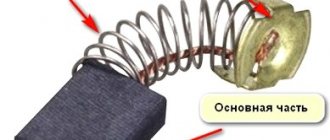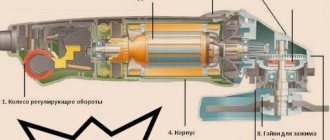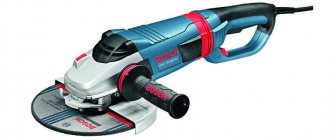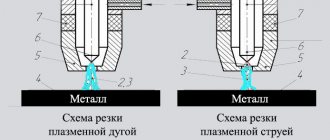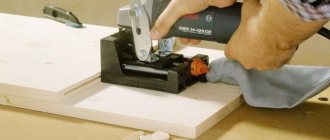Carefully! Electric current | 04/01/2016
Probably, many of you, switching TV channels on your TV, have seen advertisements for this outlandish instrument. On the Internet and on television, home repair experts assure us that this device can replace a whole set of tools and without it your continued existence is simply useless. Let's figure out whether we need to buy a renovator and what are the reviews of people who have already purchased this invaluable tool.
Content
A renovator is a tool that has many names: vibrating tool, multi-tool, multifunctional tool (MFI), vibrating cutter, oscillor cutter. The device appeared on the domestic market relatively recently, and user reviews do not help determine the advisability of a purchase: among the comments you can find both “useless” and “how I used to live without it.” Next, we will figure out what a renovator is, how it works, how to use it, and why this tool is needed in general.
What is a renovator
This is a hand-held electrical device based on the use of an oscillating drive. Rotations from the electric motor are converted into vibrations using an eccentric fork, creating vibration. Thus, the equipment performs oscillatory movements, which, depending on the model or power, are in the range of 2° - 4°.
Externally, the renovator looks like a smaller and lighter version of an angle grinder or compact angle drill, but its capabilities go far beyond highly specialized solutions. Actually, that’s why the tool is called multifunctional and universal. It can perform the functions of a grinder, a jigsaw, various cutting power tools, a grinder, a drill, a chisel and more. True, when working with a renovator, it is worth considering its advantages and disadvantages.
The main question is the advisability of using this power tool in each specific case. To get the answer you need to become better acquainted with its features.
What does its functionality depend on?
First of all, from the available set of attachments and their properties. The budget basic set consists of a straight saw blade, a scraper, a segmented saw blade and a triangular sanding platform on which the sandpapers are installed.
The complete set can amount to dozens of attachments, but in pursuit of quantity, do not forget about quality.
After purchasing the device, you can purchase additional attachments, thereby expanding your capabilities. True, you need to be prepared for the fact that the cost of a high-quality branded product can be quite high. When choosing offers from third-party manufacturers, you need to pay attention to the fixation connector. There are models with universal OIS mount. In extreme cases, there are adapters.
The relationship between technical characteristics and functionality has not been canceled. The main parameters that you need to focus on are power, supported oscillation frequency range and speed adjustment capabilities. That is why for professional models with the appropriate equipment you can find more application scenarios, not to mention the convenience, increase in speed and quality of work done.
Reviews of renovators from different manufacturers
Many reviews about renovators are very negative. A considerable number of users write about its unreliability and fairly frequent breakdowns . They also write that attachments often break, and their acquisition is problematic. Most likely, these negative opinions are associated with a large number of fakes.
Read also: Polymer materials composition structure properties binders
If you buy a good and high-quality renovator, then it will cope with its responsibilities 100%. After all, we must take into account that the mechanism of the tool is not designed for long-term work; it cannot cut through cubes of forest. Positive reviews are written by people who bought professional models. The rating of renovators Bosch, Makita and Aeg can be seen in the video.
Relatively little time has passed since the multitool became widespread. One decade of mass sales was not enough to firmly take root in the minds of the current generation of builders. Many experienced craftsmen have not yet heard of this device, or at least have not used it personally. In this article we want to dispel all possible ambiguities, talk about the principle of operation of the renovator and show video examples of using this tool.
Can the renovator replace other tools?
This is perhaps one of the main questions asked by those wishing to buy a renovator. You need to understand that this electrical device is intended for modification and precise adjustment of workpieces or surfaces. It cannot be considered a full-fledged alternative to specialized tools, although it can perform the same functions.
Let us repeat, the reason is expediency. It may take a renovator several hours to do something that a narrow-profile power tool (grinder, grinder, jigsaw, etc.) can do in a matter of minutes. For example, cross cutting of boards or panels, rough grinding of concrete. On the other hand, labor efficiency when using a renovator is much higher than when using most hand tools. You can call this solution an intermediate option.
But the main feature of the renovator is that it can be used to work in hard-to-reach places: places where it is impossible to reach with a grinder or grinder, and where it is inconvenient to use a hand tool. Plus, this multi-tool is great at reworking and allows you to do finer work for a neat fit.
The renovator will also help out when there is no specialized tool at hand.
Professional craftsmen often use MFIs instead of lifting the entire workshop to the client's floor. Especially when it comes to small amounts of work.
From this we can conclude that the renovator is a useful and multifaceted tool if used for its intended purpose. A good gift idea for a man who loves to work with his hands. An experienced craftsman will definitely find a use for this power tool, so the renovator will not just gather dust on the shelf.
Tools from Aliexpress
Many users prefer to purchase tools on Aliexpress. In stores, the price of powerful professional devices reaches 25–30 thousand rubles. The average cost of household renovators is 5–7 thousand rubles. On AliExpress you can buy a device from 2500 rubles.
NEWONE
A modern renovator operates on a 220–240 V network and has an impressive power of 350 W. It is equipped with a speed control function within the range of 11–21 thousand and weighs about 1.9 kg.
Product contents:
- additional handle;
- air outlet hole;
- vacuum cleaner socket;
- six-speed speed control;
- convenient on/off button;
- 4 nozzles.
| Price | 3,033.48 - 5,393.37 rub. |
| Discount | 35% |
| Rating | 4,9 |
| Reviews | 222 |
Buy on Aliexpress
Prostormer
A multifunctional electric tool of this brand operates at variable speed (15–22 thousand revolutions) and is powered by a 220–240 V network. Its power (300 W) is enough for cutting wood, plastic, and for grinding various surfaces, including hard-to-reach places .
Using a renovator, you can remove old varnish, paint, linoleum and carpet, and tile adhesive. The renovator weighs 1.85 kg and is not prone to strong vibration during operation.
| Price | 2,628.93 - 5,932.77 rub. |
| Discount | 30% |
| Rating | 4,8 |
| Reviews | 212 |
Buy on Aliexpress
DEKO 220V
Another Chinese renovator with a power of 300 W and an oscillation frequency of 15–20 thousand revolutions. Low weight (1.33 kg) and power supply from a standard electrical network allow you to operate the device even in continuous mode. The convenient speed regulator is combined with comfortable non-slip handles. The renovator has different attachments (13 pieces) and can work as a grinder, cutting machine, scraper, saw, grinder.
| Price | 2,022.10 - 4,887.01 rub. |
| Discount | 41% |
| Rating | 4,9 |
| Reviews | 515 |
Buy on Aliexpress
The renovator does not take up much space in the house or garage. He will help you perform a lot of construction, repair, carpentry and installation work around the house. The device will also save money on purchasing a whole set of tools.
How to work with a renovator
One of the main advantages of the device is its simplicity and convenience. To get started, you need to determine the material of the surface to be treated and the scope of work. After this, a suitable nozzle is selected. The attachment is fixed to the renovator using a hex wrench or a special quick-release mechanism. The speed of the power tool is then adjusted. Now the renovator is ready to work, and the rest depends on the skill of the master and the directness of his hands.
The following markings can be used to designate nozzles:
But more often, manufacturers use their own designations. To become familiar with the properties and purpose of the attachments, you need to study the instructions for your renovator.
Relationship between speed and machined surface:
It is also necessary to take into account the power of the power tool in order to prevent breakdowns and choose the right model:
Design and principle of operation
The whole essence of the multitool’s operation is based on the principle of oscillation (oscillations). The working nozzle moves from side to side at enormous speed, from 10,000 rpm, biting into the material or grinding any surface. The deviation of the nozzle is approximately 2-3 degrees, and differs slightly between different models. The tool poses virtually no danger to the worker, and can cause injury only with prolonged exposure to unprotected areas of the body.
Almost all renovator models have an electric drive and operate on mains or battery power. Inside the device there is a motor that transmits rotation to a spindle with an eccentric, which creates vibration on the clamp with an attachment. This characteristic only briefly outlines the essence of the renovator’s work. Modern models have a more complex structure, including an electronic speed controller, a quick-release mechanism, interfaces for additional equipment and other amenities. To see the structure of the multitool more clearly, we recommend watching a video about how the renovator works and what components it consists of.
How to choose a renovator
This tool can saw, cut, grind, polish, clean, sharpen and perform many other operations with wood, plastic, metal, concrete, brick, fiberglass, laminate, tile, rubber, etc., and with a fairly high quality of processing.
Thanks to its small size, convenience and versatility, it can replace some common tools, such as: a hacksaw, a jigsaw, a chisel, an angle grinder, scissors, a sander, a sharpener, etc. It is convenient to use, since cuts are made by submersion anywhere, which allows make neat corners, curved lines, openings and work flush, close to the obstacle, in corners and niches.
I think that everyone has already guessed that we are talking about a renovator or a vibration universal machine (aka an oscillator, a universal cutter, a multifunctional tool, an electric chisel, a multitool). As soon as he is not yet called, all the names except the first require some further explanation, and only the first is immediately clear, so in the people's memory he will still remain a renovator (however, the same thing happened with the copier and diaper). Moreover, this is not a hybrid of several familiar tools, it is a separate type, the operating principle of which is based on very fast oscillations (vibrations) of the drive, but with a very small scope. Thus, renovators can become the best assistants both in the home workshop and on the construction site, especially in those moments when accuracy, jewelry precision, or work in a very cramped and inaccessible place are required.
So, let's try to understand the many existing models of renovators and consider their differences from each other.
Selection Profiles
The owner of this profile will benefit from models with medium or high power and vibration frequency adjustment. Moreover, with sufficiently small volumes of work performed or narrow specialization, the tool can even be the main one. It is expected that the main focus will be on cutting pipes, chamfering, cutting tile joints, removing mortar residues, adhesives, grout, paint, sagging mixtures, sealants, putties, waterproofing; shaped cutting of tiles and the formation of all kinds of channels and openings will also be performed. As you use up the equipment, you can purchase both individual nozzles and entire sets for the plumber.
In this option, it is assumed that the master has a professional jigsaw and grinder in the large list of necessary tools, and the renovator is used for auxiliary, precise, neat work and where other tools can damage, stain and deform the finishing coatings. The main focus will be on sawing (including curved) fiberboards, wood and particle boards, plywood, plasterboard; installation or dismantling of frames, arches, partitions, ceilings; grinding coatings of any shape from wood, metal, plastic, concrete; cutting, installation and dismantling of floor coverings and soft materials; cutting nails, studs, pipes; trimming door blocks, baseboards, trim, laminate, parquet, as well as small milling of grooves; sawing, trimming wooden, metal, plastic profiles; grinding, fitting parts and many other operations. As you use up the equipment, you can purchase additional attachments or entire sets for the finisher.
The professions and specializations taken above as an example can be continued indefinitely: window workers, balcony workers, furniture makers, electricians, restorers and many others. They will be able to choose a renovator for themselves in accordance with the tasks and focusing on the required power, number of attachments and power system.
Well, let’s choose a renovator and learn a new profession!
Source
But still, is it worth buying a renovator?
The renovators' message is very simple; create a tool that, with the help of oscillatory movements, can cut, sand, scrape and perform other work.
The whole process takes place in the head of the tool, onto which the nozzle clings and, with the help of oscillatory movements (i.e., moves from side to side, but not in a circular motion), depending on the type of installed nozzle, performs the work processes you need, namely cleaning, cutting, grinding and so on, allowing this to be done in tight spaces due to its compact dimensions.
Keep an eye on the degree of oscillation: the lower the number, the more precise the oscillation will be, giving you more control over the application in your work.
The versatility of these tools depends on the power tool itself and the attachments that are mounted on the renovator's oscillating head. Therefore, having the flexibility to use different brands of attachments, it is important to buy an attachment for the renovator
high quality. You can view a wide selection in our online store.
With the right attachment installed on your renovator, you can sand, cut and scrape in areas that are virtually inaccessible to most other tools, or for jobs that require the utmost delicacy and precision.
Another important factor is the oscillation speed, measured in oscillations per minute, which can be adjusted depending on the task at hand. The higher the maximum oscillation speed, the higher the power the work will be performed. However, the ability to set the speed lower allows you to perform more delicate tasks.
Examples of using
Today, the multitool is most often used in sawing, cutting, grinding and for removing dried construction mixtures. To make the work of a renovator as effective as possible, it is better to use special attachments designed for specific tasks and materials. Below we list which replacement accessories are suitable for certain types of work.
Wood cutting
When working as a wood renovator, you can be sure that the cut area will be even and smooth, without any nicks. For a small amount of work, this device is excellent for trimming, sawing, or cutting through holes. Replacement attachments suitable for wood can be used when working with plastic, drywall and linoleum.
Sanding and polishing
One of the renovator’s greatest strengths is when processing small surfaces. Vibrating tools are often used for removing old paint, car bodywork, or smoothing the surface of wood. Sanding attachments have a triangular shape onto which the abrasive material is glued. The sanding sheet may have holes for better dust removal when using a vacuum cleaner.
Removal of mortars
Thanks to its vibration properties, the multitool can be effectively used as a spatula or chisel when removing dried construction mixtures. A special semicircular nozzle will help you easily clean the seams between the tiles, and with the help of a miniature spatula you can separate the glued linoleum from the floor or remove a layer of putty from the wall. Of course, it will take a lot of time for a renovator to process large areas. This tool is best used in hard-to-reach places or problem areas.
Metal cutting
Special nozzles made of high-speed steel will allow the renovator to cut metal parts. This equipment can quickly cut a nail or screw flush, saw off a pipe, or carefully cut out a damaged part of a car body. The attachments can also be used for drywall, wood and plastic.
Renovator attachments and equipment
Regardless of the approach, you need to pay attention to:
The most popular method of fixation is when the nozzle is secured with a screw (hexagon). The more expensive one allows for quick replacement of nozzles using a specially designed lock.
The most popular attachments for household use
Segmented disk.
It is made in the form of an incomplete circle, with part of a segment of complex shape or with a cut edge. Some manufacturers equip the tool with solid discs. Most often, they are all specialized according to the type of materials and the task at hand. The disc can be rasp, grinding and polishing, or saw. Inexpensive models usually have a solid platform. On more expensive ones, which have a system for connecting vacuum cleaners - with holes for dust removal. Do not forget that the installed sanding sheets must have the same holes.
Triangular attachments with diamond chips for sawing, carbide attachments, and polishing are also produced.
Depth limiter. An element that makes it possible to make cuts of certain sizes and depths, even when it is impossible to visually control the depth of the cut.
Scraper. Often also called a scraper, scraper, chisel. Used to remove residues of building mixtures and glue, to clean surfaces, trim and dismantle coatings, clear seams, etc.
With the popularity of renovators and consumer reviews, the scope of their use, the improvement of attachments, and the expansion of applied tasks are also increasing. Nowadays you can see universal holders on the market; they make it possible to include many new forms of cutters, tips, sanding attachments, saw blades, etc. in the kit.
Nozzles for concrete
Concrete work most often involves high-quality preparation of concrete surfaces for subsequent operations. In this case, the following concrete attachments for the multifunctional renovator will be useful:
- a delta-shaped sanding pad will allow you to remove mortar or tile adhesive not only from concrete walls, but also from other hard surfaces;
- scraping concrete surfaces can be greatly facilitated by using a scraper attachment: this equipment effectively removes old paint, glue, silicone and other construction compounds. The scraper for a multi-cutter is divided into hard and soft, may differ in size, most often made of high-carbon steel for soft materials HCS;
- a segmented saw attachment without an abrasive coating will allow you to quickly and efficiently make grooves in aerated concrete for communications.
Among the most popular models of multifunctional renovating tools, Bosch should be noted: blue tools are intended for large-scale professional work, green tools are intended for household work. Sets of attachments for renovators, in turn, contain everything you need: the proposed 37 attachments for wood, metal, ceramics, and concrete allow construction, installation and repair work to be carried out in a short time, with high quality and without significant effort on the part of the craftsman.
Features of choosing a renovator
Although the dust does not rise in a column during the renovator’s work, the quality of the work decreases, which is all the more important when grinding. The ability to connect a vacuum cleaner in this case is not at all an extravagance, but simply a necessity. How is the pipe connected, is it convenient or not to operate and hold the tool, how visible is the view?
Without a smooth start, it is difficult to crash into a critical part cleanly, without error.
When performing non-standard and complex work, you will quickly get tired of heavy equipment. Therefore, when buying a renovator, focus on reviews, the weight of the device and your endurance. But also remember that it’s easy to make a tool lighter with plastic, but making plastic parts durable is more difficult. High-quality winding and motor armature will always be massive.
Renovator power and supply
Based on power level, all existing models today can be divided into the following groups:
Oscillation angle, frequency and revolutions
On various products, adjustment can be stepped or smooth. The minimum limit for renovators differs significantly, and the maximum limit is usually no more than 22,000 strokes/minute. When cutting metals and hard materials, minimum frequency limits are set, for plastics - average, for plaster and soft wood - maximum, as well as for grinding work.
Equipment
Manufacturers complete the tool with several sanding sheets, cutting blades for metal and wood, and plunge-cut saw blades for wood. You can expand the functionality of the device using additional saw blades.
Toothed discs with a cutting edge in the form of sharp teeth are used for sawing metal, ceramics, and hard wood.
In addition to the cutting function, diamond-coated discs are capable of performing grinding and end processing. Diamond chips applied to both sides of the plunge-cut grinding blade allow you to machine grooves, ends and other recesses.
Serrated cut-off blades are used for cutting metal and wood workpieces, allowing plunge cuts to be made anywhere on the surface of the sheet.
Double-edged cutting knives are used for cutting soft materials: carpet, linoleum and rubber.
Sanding plates with different grain sizes of abrasive coating are used for grinding the surfaces of stone, wood, and cleaning seams and joints. They can be triangular or with rounded edges.
Sheets of sandpaper are attached to the triangular sanding pads using Velcro. They are used for grinding wood and stone. Felt pads are used when polishing surfaces.
Renovator blades for metal cutting
Manufacturers also produce equipment that is used for working with metal. The design of the equipment is very similar to products for cutting wood, and differs in the following parameters:
- has small teeth;
- There is a corresponding “Metal” marking, which indicates the possibility of working with metal.
The renovator, unlike the grinder, cuts steel much longer, so this tool is used for working with metal in exceptional cases. Such cases include sawing off protruding nails or fasteners, cutting sheet steel, and cutting steel, copper and aluminum pipes. With the help of a renovator, metal cutting is performed more accurately.
This is interesting! Metal sawing attachments can be used on wood, drywall and plastic.
The nozzle shown in the photo above has markings in the form of a ruler. It is used to control the degree of deepening of the web in the material. With its help you can cut grooves and holes with high precision.
Methods of fastening equipment
A reference article based on the author's expertise.
Any man knows what an electric drill, hammer drill, grinder or screwdriver is. But the question of a renovator puzzles many. Let's figure out what type of work it is suitable for and how to choose the right multifunctional tool.
The renovator does not have a single, established name. Similar models went on sale not long ago, and even experts call them differently. If the reader hears such expressions as “vibro-gnaw”, multi-tool, oscillating grinder/tool, universal cutter, vibrating machine, multi-master, there is no doubt that we are talking about a renovator. Although these are not the only examples of how he is “called names.”
This tool can perform many different actions. Depending on the number and type of nozzles - several dozen. But it is worth considering that the renovator is not suitable for large-scale use, for example, at a construction site.
The scope of its use is restoration of something, minor repairs, finishing work, making various crafts, and so on. If chosen correctly, it alone replaces several household tools, and ensures more accurate operations. For example, cutting samples, shaped cutting of blanks, grinding, and so on. The capabilities of a specific renovator model are reflected in its passport (instructions).
All electric tools (and multitools are no exception) are divided into groups: household, semi- and professional.
You can purchase a renovator in different ways. Option 1 – buy the tool itself, and then the necessary attachments, at retail. But only from the same manufacturer! Option 2 – take the kit. But here the question arises - what does it include? Different models from different companies come with their own set of accessories.
Conclusion - before choosing a multitool, you should decide how intensively it will be used and what, in fact, it is needed for. When a tool is needed “for all occasions,” this is one thing, but if it is needed to perform a narrow range of specific tasks, it is another.
What's the point of spending money on a large set of accessories and a powerful machine if the house has such electric tools as, for example, an angle grinder () and a drill. This will result in duplication of individual functions.
Types of Multi-Tools
According to reviews, today the most popular solution is the renovator described above. It can be in a set of home tools or replace a whole range of them. Be an additional tool for installation work, crafts, and repairs. It can even be the main tool if you do not have a large amount of one job, and you are constantly faced with non-standard and various tasks
.
Some manufacturers in multi-renovations have gone even further: an intermediate nozzle is connected to the electric drive, which makes it possible to change the operating principle of the equipment. The change in specialization occurs thanks to interchangeable heads, each of them corresponds to a specific type of tool - renovator, drill, etc. The intermediate head can make the final attachment move translationally, vibrate or rotate. These kits are called “multi-tools”; their capabilities depend directly on the configuration.
The experience of dentists in removing material from a “part,” crushing, grinding and micro-milling can be completely transferred to the world of the home craftsman. Such a set of tools, which has a traditional rotation principle, is called a “rotary engraver.” These tools are designed for small amounts of work and are perfect when accuracy and precision
. The possibilities for home use also depend directly on the set and configuration of nozzles.
An electric chisel, a hammer drill, and a miniature jackhammer belong to the “percussion engraver” section. Used for embossing and engraving. This is probably the least popular multi-tool option.
Advantages and differences between renovators
Many works that are carried out with hand tools differ only in pendulum or reciprocating movements. If we perform them electrically, but reduce the amplitude of movement of the working area by increasing the frequency, then we will have all the advantages of hand tools, and at the same time increase productivity
. As a result:
- simplicity of work, without the presence of “professionalism”;
- high quality and precision of materials processing;
- tool safety and work safety (especially in contrast to high-speed tools that create the effect of ejection of equipment and material);
- small amount of dust, minimal production of parts;
- the ability to carry out non-standard work;
- the ability to work with materials of any elasticity and hardness.
Rules for choosing a renovator
By power (kW, no more)
0.1 is quite enough for simple work with low-density materials: wood, gypsum board, plastic, linoleum, and so on.
0.2 - such a renovator allows you to perform almost all household minor repairs.
0.3 – this tool belongs to the “semi-professional” class.
˃ 0.3 – renovators with a power of 300 W or more are suitable for intensive, continuous use. They allow you to work with almost all materials.
By vibration frequency
Any renovator is, in fact, an angle grinder + an oscillator.
Therefore, in relation to a multitool, the vibration frequency of the working part is more relevant than the number of revolutions. At the upper limit, this parameter is identical for almost all renovators (about 21,000 per minute), but at the lower limit there is a difference, and a very significant one, depending on the model.
What frequencies are used for different materials:
Renovators’ passports also indicate such a characteristic as the angle of oscillation. It is almost the same for all multitools, and you shouldn’t pay attention to it. The value is determined by the design of the tool and is not subject to adjustment.
According to gearbox design
Any electric tool heats up during operation. The metal body dissipates heat more efficiently. The durability of the tool also depends on the material of the fork and eccentric, which ensure vibrations of the working part. They should be made of steel and not any soft alloys.
What's unique about the universal cutter?
If you remember that renovators are not intended to perform a large volume of work, then it is difficult to find negative characteristics among them.
Renovators produce cuts with smooth, polished edges. The multi-tool is indispensable for cutting “sandwiches” from materials of different densities.
There is very little dust when working with the multitool, and it does not fly in all directions. And with an attached vacuum cleaner, you can do minor repairs at home without preparing the room.
The first renovators used it to remove plaster in traumatology. It is difficult to get hurt with the tool. And there are no fragments that fly apart like shrapnel when the canvas is damaged.
